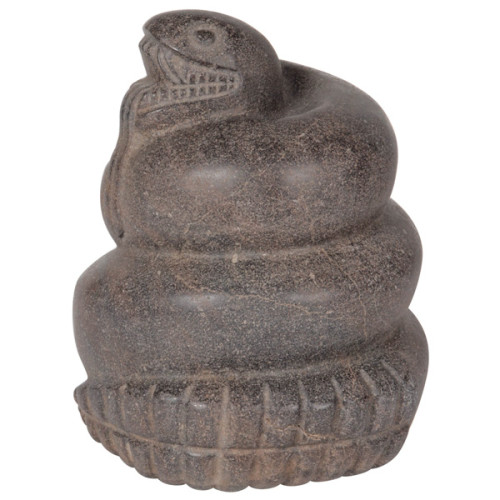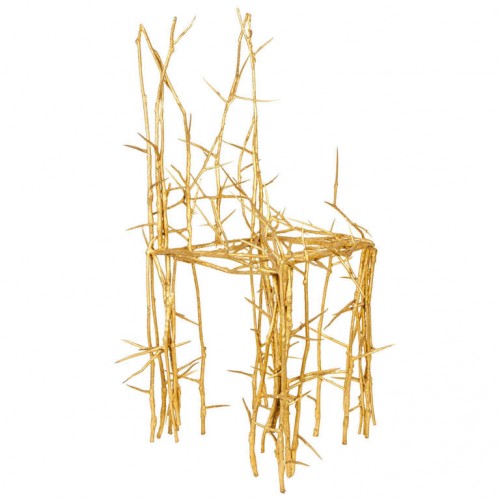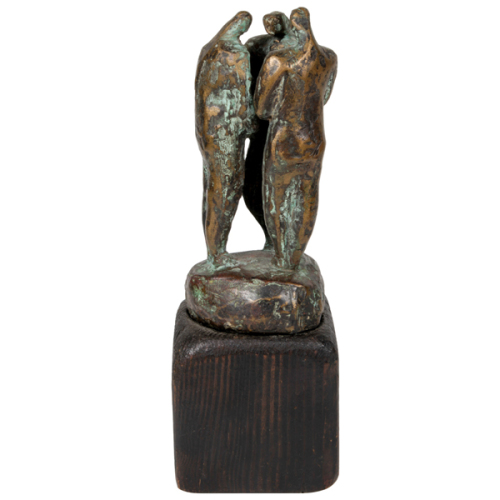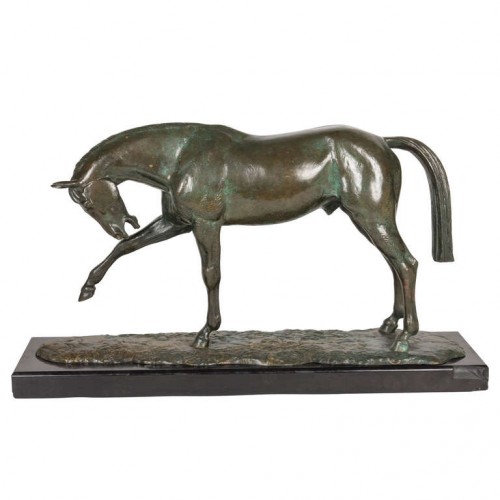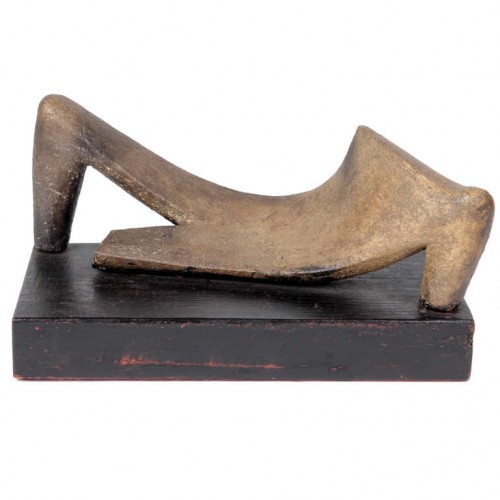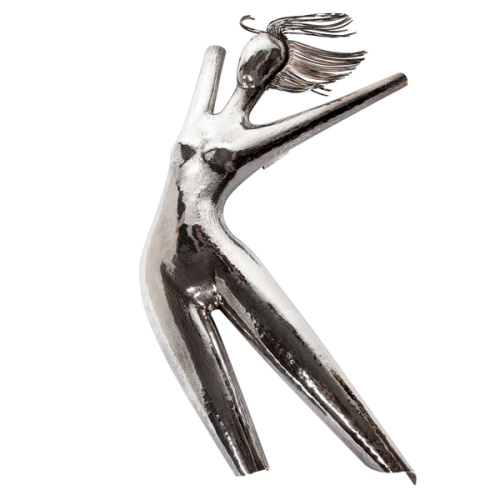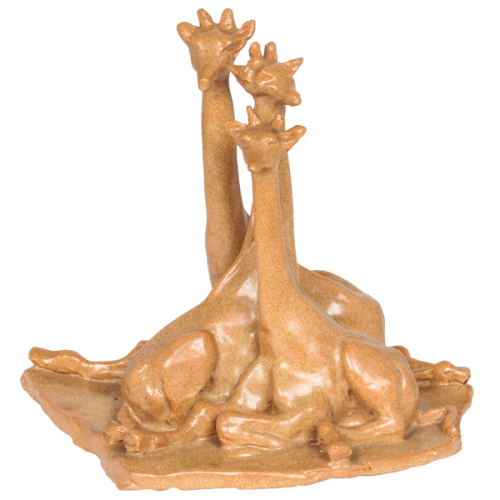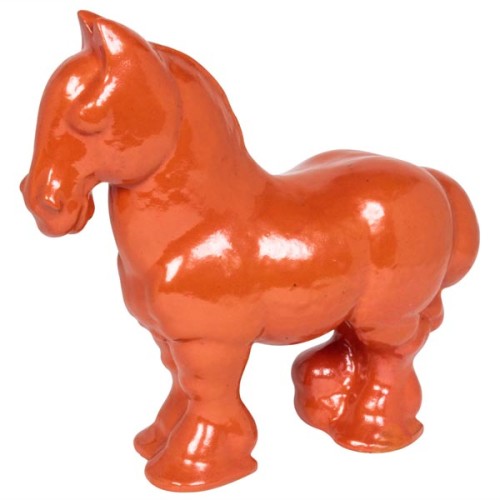sculpture
-
Asprey & Co., Important Cardinal Sculpture gem set with natural rubies, 18K gold and amethyst quartz, signed,1980
ASPREY & CO. LTD. (founded 1781) London, UK
Important Natural Ruby Gem Set 18K Gold Cardinal Bird Sculpture 1980
Finely chased and chiseled 18K yellow and white gold realistically rendered sculpture of a Cardinal bird set with
85+ carats (approx.) of natural gem quality oval and round cut Burmese rubies (GIA certificate) further heightened with enamel eyes and blackened gold face plumage details, the 18K gold and natural ruby cardinal sets atop a natural Amethyst crystal “mountain rock” with a tooled and gilt (script mark) on the leather under-pad.Marks: A & Co. (in a quatrefoil), Crown mark, 750 (gold standard mark) Lion’s head (London assay mark) “F” date mark for 1980, tooled and gilt Asprey (script mark) on the leather under-pad
Provenance: Privately commissioned by the Sultan of Brunei’s younger brother, Prince Jefri Bolkiah who also later became the owner of Asprey & Co in the 1995. This rare sculptural 18K gold and natural ruby Cardinal was handmade by the finest jewelers and work masters in the workshop of the London Asprey & Co. located above the flagship store at 167 New Bond Street.
H: 3 ¾” x L: 5 3/4” x W: 1 ½”(Cardinal only)
H: 6” x W: 6 ¾” x D: 5 ¾” (with Cardinal atop natural Amethyst crystal rock)As one might guess, a large part of the animal symbolism of the cardinal comes from the brilliant red color of the males. In fact, its name is derived from the royal red vestments worn by Catholic cardinals. This shock of red, especially against the stark backdrop of winter snow, is a magnificent sight. The male cardinal reminds us passion, warmth and vibrancy is available to us – even under the cloak of Winter’s grey clouds. Interestingly, the more bold and bright his color is, the more successful the cardinal will be at prolonging his lineage. Dull colored male cardinals are less likely to mate successfully than bright colored ones. True to the fire of his color, the crimson cardinal has got some major spunk. He will aggressively defend his territory, and fight attackers with ferocity. Indeed, they have been known to fight ghost males (their reflections) in mirrors for hours on end. Both male and female give us glorious songs. Along with peeps and pips and warbles, the tuned ear can also hear “cheer, cheer, cheer!” Very appropriate to the animal symbolism of cardinals, because they are a delight to both eyes and ears. The cardinal makes a fantastic animal totem. It reminds us to hold ourselves with pride, not ego pride but rather the cardinal asks us to stand a little taller, be a bit more regal and step into our natural confidence as if we were born to lead with grace and nobility. Those who attract the cardinal as their totem are naturally energetic, love life, and happily help others where and when they can!
-
Aztec AD 1325-1475 Important stone carved sculpture of a coiled serpent
AZTEC AD 1325-1475 Mexico.
Important stone carved sculpture of a coiled serpent, AD 1325-1475 Mexico.
***Two scientific authentication reports are available with this sculpture.
H: 10″ x D: 8″
The serpent played a very important role in Aztec religion and was represented in a variety of forms. The majority of the serpents represented in Aztec sculpture are rattlesnakes.
Mexican mythology indicates the snake is a symbol of veneration, worship and honor. Often a symbol of great power, resurrection and rebirth, the snake continues to be a powerful emblem of renewal and transition.
Further, the snake is recognized as a symbol of humanity as a whole. Interestingly, the Mexican perspective provides hope for mankind to aspire to great heights as it correlates the shedding of the serpent’s skin to man’s ability to change his own circumstances and overcome adversity.The Aztecs build an impressive empire in the valley of Mexico. This thriving area, known as Tenochitlan, was the cultural, religious and trading center of Mesoamerica. Aztecs were the Native American people who dominated northern Mexico at the time of the Spanish conquest led by Hernan Cortez in the early 16th century. According to their own legends, they originated from a place called Aztlan, somewhere in north or northwest Mexico. At that time the Aztecs (who referred to themselves as the Mexica, or Tenochca) were a small, nomadic, Nahuatl-speaking aggregation of tribal peoples living on the margins of civilized Mesoamerica. Sometime in the 12th century they embarked on a period of wandering and in the 13th century settled in the central basin of México. Continually dislodged by the small city-states that fought one another in shifting alliances, the Aztecs finally found refuge on small islands in Lake Texcoco where, in 1325, they founded the town of Tenochtitlan (modern-day Mexico City). The term Aztec, originally associated with the migrant Mexica, is today a collective term, applied to all the peoples linked by trade, custom, religion, and language to these founders. Warriors and pragmatic builders, the Aztecs created an empire during the 15th century that was surpassed in size in the Americas only by that of the Incas in Peru. As early texts and modern archaeology continue to reveal, beyond their conquests and many of their religious practices, the Aztecs had many positive achievements: the formation of a highly specialized and stratified society and an imperial administration, the expansion of a trading network as well as a tribute system, the development and maintenance of a sophisticated agricultural economy (which was carefully adjusted to the land) and the cultivation of an intellectual and religious outlook that held society to be an integral part of the cosmos.
-
African Bronze “Tree of Life” Sculpture 20th Century
African Bronze “Tree of Life” Sculpture 20th Century
Sand cast bronze with a brown black patina with golden highlights in an open work design depicting 18 figures perched on a tree form with various intricate pattern details.
***As a Primitive / Tribal sculpture this piece visually relates to some of the sculpture and painting of the renowned French artist Jean Dubuffet.
H: 18 1/2″ x D: 4″ x W: 8″
-
Michele Oka Doner Terrible Chair sculpture (unique) 1981
MICHELE OKA DONER (b. 1945) USA
Terrible Chair (unique) 1981
Gilded bronze
Illustrated: Michele Oka Doner, Natural Seduction, S. Ramljak, M. Lapidus, A. C. Danto (New York: Hudson Hills Press, 2003), p. 85
H: 31 ½” x W: 15” x D: 17 ½”
Excerpt from “The Furniture of the Universe” by Arthur C. Danto in Michele Oka Doner: Natural Seduction (New York: Hudson Hill Press) 2003 p. 30
The Terrible Chair
What drew me initially to the work of Michele Oka Doner was the way it acknowledges the rhetoric of sitting and the metaphorical language of furniture and, most particularly, of the chair. Consider, for examples, the work she calls Terrible Chair which a distant affinity to Adirondack furniture as it is cast from a prototype fashioned out of branches. The Adirondack chair itself refers more directly to the forest; it is made of branches and looks as If nothing more than an axe or a hunting knife were needed to construct it. It proclaims the skill of the woodsman prevailing over the forest by seeing it in terms of opportunities for survival rather than representing threats and dangers. The Adirondack chair is a domesticated tree, a bower and as much a testament to the superior power of the seated as a chair with clawed or hoofed legs, in which we sit as master over beasts. The proper habit for it is the hunting lodge, with bearskin rugs suitably prone on the look or the long veranda of a mountain chalet.
Terrible Chair is made of thorned branches, which have a certain menacing beauty but no real use unless to fashion a mocking crown. Oka Doner is drawn to natural objects; they are her models and her motifs, the source of her metaphors. She saw a thorny branch that she found on a neighbor’s property a clear challenge: “The way the thorns were arranged was exquisite,” she recalled. But those same thorns were too threatening to invite physical approach. A thorned plant has an evolutionary advantage because it refuses to yield to human use. This was an irresistible dare to an artist bent on turning the natural into the meaningful.
Terrible Chair is a victory; it defines what it means to be an artist in Oka Doner’s conception of that role. It is equally a victory for the thorns because the utility promised by the chair they form remains unavailable to sitters: the thorned sticks are available only as art but not for use. The radical unusability of the work constitutes a draw in the match with nature, and the bronze in which it is cast forms a suitable monument to that context. Terrible Chair enshrines an objective contradiction.Nonetheless, the components of the Terrible Chair are combined to form a chair, but because there is no seat, no one would know how to use it in a conventional way. There have been treacherous chairs that have concealed their treachery, subverted the confidence shown in the act of sitting—chairs that collapse beneath their users, The Marquis de Sade offered chairs to female sitters that rotated them through an abrupt arch onto their backs and into a position of sexual accessibility from vertical dignity to horizontal vulnerability. By contrast, no one is tempted to sit on a Terrible Chair so dignity is at least not put in threat. So what is its meaning? In its outward inhospitality, the work says, in effect, “This chair is not for sitting.” It has to have the form of a chair to deliver this message. It excludes the chair from use as if to underscore the message, it excludes the chair from use as if to deliver the truth that chairs count in the game of meanings, transmitting auras to their occupants. It acquires a fairy tale inaccessibility like the glass slipper in Cinderella into which only the tiny foot of a natural princess can slip. Terrible Chair— a name, the artist told me, her two sons helped select—promises to transform whoever claims it. But clearly we are not its intended occupants. So it stands as a reminder of the higher meanings of chair to those who may have relegated them to the drab language of utility. Through its thorny point, brandished like the spikes on medieval armor, Terrible Chair transfers itself the power that sitting in it would confer.
I think of Terrible Chair as Oka Doner signature work, transmitting the message through its sharp spins that although she makes chairs, she is no a designer but an artist. And though the chair is part of the domestic lexicon, her project is to bring meaning rather than comfort. Should her work provide comfort, it is an incidental by-product of a class that acknowledges human needs but transform their satisfaction into symbolic acts and cosmic endorsements. Gesturing toward the spiky, spiny objects that furnish her tremendous loft—transfigurations of natural forms cast in various metals that carry their own system of meanings—Oka Doner draws attention to the fact that nothing here is upholstered. She likes the hard, the skeletal, the pronged and edgy armature of carapace, the natural scaffoldings t hat give shape and structure to the vulnerabilities of living things. It is the inner architectures whose natural powers we acquires as our own when we use those forms as evocations and signs , in the manner in which peoples who live close to nature use teeth, their claws, the furs and the feathers of wild animals as talismans of great power. Her furniture consists of so many apertures through which the cosmos enters the space of domestic life, transforming a utilitarian object into something that transcends that use and transforms the user into a participants in a celestial trial. Her aim, she confides, is to ritualize ordinary life. And this is an artistic practice far more deeply connected with the meaning than making things to hang on walls or stand in corners simply for visual delectation.
MICHELE OKA DONER (b. 1945) New York, NY
Michele Oka Doner is an internationally acclaimed New York-based artist and designer whose work translates natural forms–plant fronds, berries, shells, and life observed beneath the lens of the microscope–into objects of extraordinary power and seduction rendered in bronze, precious metals and stones, concrete handmade papers, ceramic, and now, glass. Since first appearing on the national scene in 1970 as the youngest artist showcased in the defining landmark museum exhibition Objects USA. Oka Doner has built a career encompassing monumental sculptures, public art, jewelry, and functional objects that range from fireplace tools to evening bags.
Oka Doner was born in Miami Beach in 1945. Though she received her formal education and advanced degrees at the University of Michigan in Ann Arbor, the artist has always cited as her primary laboratory the turbulent natural treasures of Southern Florida’s oceans, tidal pools, beaches, gardens and tropical forests–boundless living resource libraries she visits on a monthly basis to gaze upon and gather samples that later inspire pieces of every size and type. Oka Doner has said that she strives with her work to “play the role of the translator and editor of life forces creating objects that go far beyond static formal beauty to encourage contemplation and wonder.” Informed by her ongoing research into scientific literature and poetry, as well as her expeditions in the natural world, Oka Doner uses the tools of physical expression to invite us along on her wanderings through the realm of the infinite.
Oka Doner is also admired for her numerous site-specific, permanent public art commissions including such projects as the golden tiled Radiant Site at New York’s Herald Square Subway Station (1990) and A Walk on the Beach, a half-mile long expanse of terrazzo and bronze floor continually unfolding at Concourse A of Miami International Airport (1995 to present). Oka Doner’s sculptures and functional objects are included in many prestigous private and public collections, including those of The Metropolitan Museum of Art and the Smithsonian’s Cooper-Hewitt National Design Museum in New York City, the Art of Institute of Chicago and the Virginia Museum of Fine Arts, among others. She has participated in scores of distinguished exhibitions internationally and has been recipient of numerous grants and awards, including honors from the Kress Foundation and the New York State Council for the Arts. In 2004 she received the coveted Award of Excellence from the United Nations Society of Writers and Artists. -
Jan de Swart, Handcarved “Peach” Sculpture, c.1970
JAN DE SWART (1908-1987) Netherlands / USA
Peach sculpture c. 1970
Hand carved and formed jelutong wood in a symbolic / erotic form of a peach
For more information see: Jan de Swart: A Day That Becomes a Lifetime, exhibition catalogue (California: Fine Arts Gallery at the San Fernando Valley State College, February 1972); Jan de Swart, Mike McGee and William G. Otton (Laguna Beach, California: Laguna Art Museum, 1986).
H: 7 ½” x D: 4”
Price: $7,500
Constantly seeking and inventing new materials Jan de Swart was a true modernist. He was influenced by artists such as Isamu Noguchi, Harry Bertoia, Charles Eames, and later Sam Maloof and Wendell Castle. Although he had been creating small sculptures since his arrival in California from Holland in 1929, he had not been widely recognized until being introduced to John Entenza, publisher of Arts & Architecture magazine in 1947. Soon thereafter, he was able to create larger works and began collaborating with architects such as Whitney Smith and Victor Gruen on special commissions. His work is in the permanent collection of Los Angeles County Museum of Art, The Smithsonian, and the Ford Foundation. He was honored with the American Institute of Architects Gold Medal for Sculpture in 1965.
-
Raymond Barger Post-War Polychrome wood Sculpture c. 1955
RAYMOND BARGER (1906-2001) USA
Sculpture c. 1955
Polychrome contoured wood of interlocking circular forms in white, blue and pink on a bronze base.
Signed: RB (artist initials), USA, Z0I
H: 8 1/2” x L: 12 ¾” x D: 8
Price: $5,800
Raymond Granville Barger was a sculptor working in metal, plastelin, and bronze among other materials. Barger was educated at Carnegie Institute of Technology and Yale University School of Fine Art. He received a Winchester Fellowship from Yale, and a special fellowship from the American Academy in Rome. Barger moved to California, where he died in 2001.
-
Mayo Martin Johnson / American Post-War bronze sculpture 1960
Mayo Martin Johnson (b. 1904) USA
“Summit Conference” 1960
Patinated bronze with a verdigris patina in the recessed areas and natural bronze highlights, original wooden plinth / base.
Marks: Red painted museum accession marks
For more information see: American Art, ed. Peter Hastings Falk (Madison, Conn.: Sound View Press, 1985) p. 317.
H: 10 ¼” on plinth
Price: $6,000
-
Andre Vincent Becquerel Arabian Horse bronze sculpture c. 1930
ANDRE VINCENT BECQUEREL (1893-1981) France
Arabian Horse sculpture c. 1930
Bronze with overall rich green/brown patina with intricate sculpting and details, black Belgian marble plinth base
Signed: A. Becquerel (inscribed in the bronze)
H: 12” x W: 21” x D: 6”
Price: $27,500
Andre Vincent Becquerel was born in St. Andre-Farivilliers. He studied at the l’Ecole des Beaux Arts in Paris under Hector Lemaire and Prosper Lecourtier. He specialized in fine animal sculpture and regularly exhibited at the Salon des Artistes Francais from 1914 to 1922. Becquerel worked for the Editeur Parisiens Edmond Etling in Paris and created a monumental sculpture in patinated plaster for the “Pavillon international” at the Exposition Internationale in Paris in 1937.
-
Gertrude Burgess Murphy American Modern Post-War Reclining nude sculpture c. 1950
GERTRUDE BURGESS MURPHY (b. 1899) USA
Reclining nude sculpture c. 1950
Fired and glazed earthenware on a wooden base
Marks: original paper exhibition label (San Francisco Museum of Art, Rental Gallery); tape with the name of the artist
For more information on Murphy see: Who Was Who in American Art, ed. Peter Hastings Falk (Madison, Conn.: Sound View Press, 1985), p. 439.
H: 5 7/8” x L: 10 5/8” x D: 5”
Price: $11,500
-
Emma Luna “Stack of terry wash cloths” sculpture
EMMA LUNA California
Stack of terry wash cloths
Emma Luna has become increasingly known for her work in ceramic sculpture and mixed media on paper. A native of the Dominican Republic, she has lived from age 14 in the United States. She has a B.S. degree in Art Education from the University of Minnesota. Before moving to California, she lived in Cambridge, Massachusetts, where, while working as an art teacher, she obtained a B.F.A. in painting at Massachusetts College of Art and was associated with the Radcliffe College Ceramics Studio at Harvard University. There she learned the technique of raku ceramic firing. Her ceramic sculptures have been shown at SOFA New York, SOFA Chicago, and in Los Angeles.
EMMA LUNA Statement
My sculpture reproduces everyday fabric objects such as washcloths, socks, and just about anything I can get my hands on to reproduce, utilizing the illusionist possibilities inherent in clay as a medium. However, I render this illusion so that the ordinary object simultaneously produces an impression on the extraordinary. Rows of rolled hands towels, piles of terry cloths whose positions defy gravity, a chaotic pile of laundry frozen in shapes that the fabric itself could never hold, and so forth.
Mine is a voyage of intimate exploration into a subliminal form shared by both clay and fabric: the fold. At the same time, my work de-familiarizes an anonymous and routine form of ‘women’s work’ whose aesthetic possibilities no one but a woman would be likely to apprehend.
EMMA LUNA Resumé
Selected Solo Exhibitions
2006 Mixed-media on paper, John Natsoulas Gallery, Davis, CA
2006 “Art Journey’s Back to the Long, Long Ago and Far Away,” Mixed-media on paper, The International House, Davis, CA
2004 “Corazones,” Gallery Casa de Chavón, Santo Domingo, Dominican Republic
2003 Sam Houston State University Art Gallery
2003 John Natsoulas Gallery, Davis, CA
2003 UC Davis Alumni Center Gallery, Davis, CA
1999 “Impressions,” Memorial Union Art Gallery, University of California, Davis, CA
1986 “Latin American Images,” Austin Arts Center, Trinity College, Hartford, CT
1985 Gallery 57, Cambridge Art Council, Cambridge, MASelected Group Exhibitions and Galleries
2013 “Black, White, Red – A Sculpture Show,” A New Leaf Gallery | Sculpturesite, Sonoma, CA
2013 “Clay & Glass National Juried Exhibition,” Association of Clay and Glass Artists of California (ACGA), City of Brea Art Gallery, Brea, CA
2013 National Art Competition, Pence Gallery, Davis, CA
2012 Christopher Hill Gallery, St. Helena, CA
2011-2012 Crocker Museum Shop, Crocker Art Museum, Sacramento, CA
2010-2012 Erin Martin Design, St. Helena, CA
2009-2012 Davis Artists’ Cooperative Gallery, Davis, CA
2007-2012 A New Leaf Gallery | Sculpturesite, Sonoma, CA
2009-2011 F Dorian, San Francisco, CA
2010 “Sculptural Objects & Functional Art (SOFA),” Navy Pier, Chicago, IL
2010 “3rd Annual Trompe L’oeil,” John Natsoulas Gallery, Davis, CA
2009 “Small Works,” John Natsoulas Gallery, Davis, CA
2009 Amoca, Pomona, CA
2009 “The Uncommon Object,” Pence Gallery, Davis, CA
2008 “Women Painting Women,” Pence Gallery, Davis, CA
2007 “Biannual Juried Art Show,” Sonoma Museum of Art, Sonoma, CA
2003-2007 Annual Auction Art Show, special invitation, Crocker Art Museum, Sacramento, CA
2000-2007 Mostly Glass, Englewood, NJ
2004-2006 “Sculptural Objects & Functional Art (SOFA),” New York City, NY
2001-2006 “Sculptural Objects & Functional Art (SOFA),” special invitation, Navy Pier, Chicago, IL
2005 “One Hundred Socks,” Sonoma Valley Museum of Art, Sonoma, CA
2006 “The Flatlanders,” special invitation regional show, University of California, Davis, CA
2006 Ceramics, John Natsoulas Gallery, Davis, CA
2006 Art Foundry Gallery Group Show, Sacramento, CA
2005 “Realism in Art Juried Art Show,” Mostly Glass, Englewood Cliffs, NJ
2005 “Sonoma County Juried Group Show,”The DiRosa Preserve, Napa, CA
2004 Amdur Gallery, Glenview, IL
2004 “Primavera ’04,” Artists-in-Residence show, Fundación Centro Cultural Altos de Chavón, La Romana, Dominican Republic
2004 “Corazones Perros,” Museo de la Cerámica Contemporánea, Santo Domingo, Dominican Republic
2003 Gallery Arte Tamburini, La Romana, Dominican Republic
2003 “Otoño 2003,” Artists-in-Residence show, Fundación Centro Cultural Altos de Chavón, La Romana, Dominican Republic
2002 “Crocker-Kingsley 73rd Invitational Group Exhibition,” Crocker Art Museum, Sacramento, CA
2001 “Reality Check,” juried art show, Ohio Craft Museum, Columbus, OH
2001 Craft Museum, City of Davis First Juried Exhibition, Davis, CA
2001 “Small Ceramics Art Show,” Academy of Design, New York City, NY
2001 “Palm Springs International,” Palms Springs, CA
2001 “Ceramics 30,” John Natsoulas Gallery, Davis, CA
2001 “Sculptural Objects & Functional Art (SOFA),” The Armory, New York City, NY
2001 “All Creatures Great and Small,” John Natsoulas Gallery, Davis, CA
2001 “Los Angeles Art Show,” UCLA, Los Angeles, CA
2001 “Two Decades,” John Natsoulas Gallery, Davis, CA
2001 California Conference on Clay Arts, John Natsoulas Gallery, Davis, CA
2001 Invitational show, Sutter Club, Sacramento, CA
1999 “Celebrate Ceramics,” Handworks Gallery, Acton, MA
1999 Blooming Art Gallery, Sacramento, CA
1999 California Association of Ceramic Artists show, Jeff’s Objets d’Art, Davis, CA
1998 Artists-in-residence show, Altos de Chavón Gallery, La Romana, Dominican Republic
1998 Oannes Gallery, Tiverton, RI
1996 Craigin-Fife Gallery, Brookline, MA
1995 Invitational show, Concord Art Association, Concord, MA
1995 “Within Gender,” invitational show at A Conference on Latin American Literature, Montclair State University, Upper Montclair, NJ
1991 “Voces Prevalecientes,” group show of Hispanic Artists, Firehouse Multicultural Arts Center, Jamaica Plain, MA
1990 “The Space,” organized by the Hispanic Office of Planning and Evaluation (HOPE) as a benefit for AIDS education, Boston, MA
1986 “Taming the Beast,” three-person show, Cambridge Multi-Cultural Arts Center, Cambridge, MA
1986 Dominican artist’s exhibit, Essex County College, Newark, NJ
1985 Group show of women’s paintings, Massachusetts College of Art, Boston, MASelected Collections
Museo de la Cerámica Contemporánea, Santo Domingo, Dominican Republic
Ohio Craft Museum, Columbus, OH
Hawaii State Art Museum, Honolulu, HI
Arizona State University Ceramic Museum, Tempe, AZ
The White House Christmas Tree Ornament Collection, Washington, DC
Sandy Bessen, Sante Fe, NM
Edinhurt Gallery, Don Merrill, Beverly Hills, CA
Barbara Fromm, Palm Desert, CA
Bea Larsen, Cincinnati, OHSelected Honors & Awards
2013 Third Place Winner, ACGA’s “Clay & Glass National Juried Exhibition,” La Brea, CA
2009 Honorable Mention, Sonoma Valley Museum of Art Biennial, Sonoma, CA
2007 Second Place Winner, Sonoma Valley Museum of Art Biennial, Sonoma, CA
2003-2004 Fulbright Fellowship, Parsons School of Design, Los Altos de Chavón, La Romana, Dominican Republic
2002 Invited to create an ornament for the White House Christmas tree, now part of the White House collection
2002 Woodland Art Council Teaching Award
1999 Pollock-Krasner Foundation Artist’s Grant ($10,000)
1999 Three mixed media on paper works acquired by Canadian artistic design firm D-Zign I.P.P., Inc.
1997-1998 “Two Collection,” juried selection of arts and crafts selected for WGBH/Channel 2 Auction
1994 Three monotype prints acquired by the Fogg Art Museum, Harvard University, as part of the museum’s print lending-librarySelected Publications and Media
2013 “Clay, glass elevated in Brea,” review of ACGA show by Richard Chang, photo of sculpture “Las Toallitas de mi Abuela,” The Orange County Register, February 2. 2006 “Emerging,” book cover and article by Rita de Maeseneer, Encuentro con la Narrativa Dominicana Contemporanea, p. 230-233, Iberoamericana, Vervuert, Belgium.
2006 “Memory’s Allure,” review by Suzanne Munich, Davis Enterprise Newspaper.
2006 Wheel-throwing demonstrations for KCRA TV news, April and June.
2005 “Working Gender,” Cultural Representation of Women and Labor, Brujula University of California, Davis, Volume 4 Number 1, December.
2004 “Emma Luna’s Hearts,” article by Stephen Kaplan, Ceramics Monthly Upfront, December.
2004 “‘Corazones’ de Emma Luna,” El Caribe, Santo Domingo, Dominican Republic.
2004 “Dominican Sojourn,” article and interview by Aldrich Tan, The Davis Enterprise.
2003 “Taking Artistic Wing,” article by Marilyn Moyle, The Davis Enterprise January 30.
2002 “Illusionism without Illusions,” article by Neil Larsen and Susan Kaiser, Ceramics Art and Perception, Issue 50.
2002 Article and interview by Janine Tully, guest lecture and presentation to the Hawaii Craftsman Raku Ho’laule’a conference , Honolulu Star Bulletin, May 26.
2001 Featured on “Modern Masters” television show, Home and Garden Cable Network, May 20
2001 “Celebrating Clay,” front page photo and article by Paul Dorn, The Davis Enterprise Weekend, May 3.
1999 “‘Celebrate Ceramics’ Draws a Crowd,” photo and article by Libbie Payne, The Boston Globe, October 10.
1999 Preview of “Impressions,” Memorial Union Art Gallery, article by Steven Jenkins, Artweek, Issue 7/8.
1999 “Multi-talented Artist Displays Work at MU,” feature article by Beth Rose Middleton, The California Aggie, UC Davis, August 2.
1999 Faculty Show, Davis Art Center, reviewed by Kimi Julian, Sacramento News and Review, January 14; By Melissa Leavitt, The California Aggie, January 14; By Marilyn Moyle, The Davis Enterprise, January 28.
1998 Group Sculpture show, Oannes Gallery, Tiverton, RI, reviewed in Art New England Magazine.
1998 “Notas Culturales,” taped interview with Luz Vicioso, Channel 19, La Romana, Dominican Republic, August 24.
1998 “Caña TV,” live interview for the Luisa María Ortiz Show, La Romana, Dominican Republic, Aug. 15.
1998 “Las Huellas del Caribe en Altos de Chavón,” article by José Bautista, El Siglo, Santo Domingo, Dominican Republic, July 23.
1996 Artist’s Profile in Ceramics Monthly Magazine, June-August.
1995 “The Arts and Craft of Emma Luna,” feature article by art critic Christine Temin, The Boston Globe, March 1.
1990 “Centro,” interview by the Boston NBC affiliate’s Spanish language public affairs program.Academic History and Professional Experience
Private Art Instruction, home studio (present)
1998-2013 Research Specialist, Printmaking Lab, University of California, Davis, CA
2009 Guest speaker and presenter at ceramics workshop at the Crocker Museum of Fine Art
2005-2006 Freelance Art Teacher, Merryhill School, Davis, CA
2006 Guest speaker and presenter on KVIE Television Guest Artist Series, Sacramento< CA
2006 Guest speaker and presenter at the California Association of Ceramic Art Conference, John Natsoulas Gallery, Davis, CA
1999-2003 Freelance Art Teacher, Davis Art Center, Davis< CA
2003 Invited to lecture and conduct a three-day ceramic sculpture workshop at Sam Houston State University Art Gallery, Houston, TX
2002 Presentation and lecture at the Honolulu Academy of Art
2002 Clay demonstration at the University of Hawaii Windward
2001 Guest speaker and presenter at the California Association of Ceramic Art Conference, John Natsoulas Gallery, Davis, CA
1985-1998 Art Teacher (Full-time), Boston Unified School Department, Boston, MA
1998 Visiting Artist, University of California Davis Craft Center, Davis, CA
1998 Artist-in-Residence (ceramics and sculpture), Parson’s School of Design, Los Altos de Chavón, La Romana, Dominican Republic, June-August
1997 Workshop on saggar-firing and terra sigillata techniques, Radcliffe College ceramics studioEducation
1986 Massachusetts College of Art, BFA, Painting
1983 University of Minnesota, BS, Art Education -
Fred Borcherdt Abstract sculpture c. 1970
FRED BORCHERDT
Abstract sculpture c. 1970
Lacquered red wood on an orange plexiglass base
-
Guy de Rougemont Puzzle Sculpture c. 1970
GUY DE ROUGEMONT (b. 1935) Paris, France
“Puzzle” sculpture c. 1970
Lacquered PVC in a rounded movable puzzle form with interlocking pieces.
H: 24 1/2″ x L: 26″ x D: 11″ (closed)
H: 24 1/2″ x W: 26″ x D: 11″
Price: $24,000
Guy de Rougemont is a French painter and sculptor and is famous for his use of vibrant geometric motifs. His works are a perfect blend of pop art and minimalism. In 1990, the Musée des Arts Décoratifs in Paris (Museum of Decorative Arts) presented an important retrospective about this major contemporary French artist, member of the prestigious French Académie des Beaux-Arts. ROUGEMONT, Espaces publics et Arts décoratifs, 1965-1990, Musée des Arts décoratifs, Paris, 5/22/1990 – 08/19/1990
-
Egide Rombaux (attr.) Belgian Art Nouveau “Nymph and Iris” sculpture c.1900
EGIDE ROMBAUX attr. (1865-1942) Belgium
Nymph with Iris Blossoms c.1900
Finely hand carved ivory in the form of a full figure nymph with an iris blossom and buds, blue agate base with gilt bronze mounts
For more information see: Art Nouveau and Art Deco Lighting, Alastair Duncan (New York: Simon & Schuster, Publishers, 1978)
H: 9 1/2″
Price: 9,750
Egide Rombaux, born 1865 in Brussels, was the son of the sculptor Félix Rombaux and student of Charles van der Strappen and Joseph Lambeaux. Rombaux was one of the more eminent of the Belgian School at the turn of the century; he was awarded the prestigious Prix de Rome in 1891, and subsequently became a professor at the Institut superieur des Beaux-Arts in Anvers. Sculptor and medalist, he principally did ivory groups (such as his ‘Venusberg’, displayed at the 1897 chryselephantine Tervuren exposition, and his ‘Daughter of Satan’, now at the Musée Royale des Beaux-Arts in Brussels), portrait busts and statues. He also collaborated with silversmith Franz Hoosemans on a delightful range of candelabra and tablelamps.
-
Salvatore Meli Important large scale Italian Sculpture / Ewer 1952
SALVATORE MELI (b. 1929) Italy
Important Sculpture / Ewer 1952
Glazed terra cotta, brown and dark green with white scraffito decoration, original stepped and angular wood base.
Signed: Meli 1952 Roma
For more info on Meli see: Design 1935-1965, What Modern was, ed. Martin Eidelberg (New York: Harry Abrams, 1991) p. 237.
Salvatore Meli belongs to that initial group of artists, including Guido Gambone and Lucio Fontana among others, who elevated Italian ceramics to a fine art during the post-war period. Meli conceived this vessel, first on paper, then by laboriously constructing the body in clay, coil by coil, to achieve the richly textured and dynamic form; the incised and painted decoration is in concert with the organic shape. The massive scale of this work defies function as a ewer but was created as a sculptural object. The original wooden base recalls Italian futurist sculpture forms of the early twentieth century.
H (with base): 23 1/2” x W: 13” x D: 9.5”
H (without base): 19 1/8”Price: $27,500
-
Karl Schmidt / Hagenauer Werkstätte Sterling nude sculpture c. 1965
KARL SCHMIDT (b. 1948) Vienna
HAGENAUER WERKSTÄTTE ViennaSculpture c. 1965
Handwrought sterling silver repoussé in the form of a nude with blowing hair
Marks: SCHMIDT WIEN MADE IN AUSTRIA 925 (silver standard) KS (artist initials)
For more information see: Metallkunst, Karl H. Bröhan (Berlin: Bröhan Museum, 1990) pp. 200-205; Werkstätte Hagenauer 1898-1956, (Vienna: Österreiches Museum für angewandte Kunst).
H: 17 1/4″ x W: 12″ x D: 2 3/4”
Price: $17,500
-
Hulda Rotier Fischer Art Deco “Giraffes” handbuilt glazed pottery sculpture 1936
HULDA ROTIER FISCHER (1893 – 1982) Milwaukee, WI
Three-resting giraffes sculpture 1936
Handbuilt earthenware sculpture with a golden light brown glaze.
Marks: Hulda Rotier Fischer 36 (hand incised)
H: 6 1/2″ x W: 7″ x D: 5 1/2″
Price: $2,300
Hulda Rotier Fisched studied at the Milwaukee Normal School and was a student of Robert von Neumann Sr. In 1921 she also studied with Carl Holty. She worked as an Art Instructor at Shorewood Opportunity School for 30 years. Rotier Fischer was a Member of the Milwaukee Art institute.
She is the recipient of many Milwaukeee Journal Awards.
-
Walter Paul Suter, American Art Deco glazed pottery sculpture 1929
WALTER PAUL SUTER USA
AMERICAN ENCAUSTING TILING CO. New York, NY
Art Deco Seated Female Figure with Draped Skirt and Holding an Art Deco Vase 1929
Hand-modeled and molded cream glazed earthenware figure with gold and silver details on a separate, but matching black glazed earthenware base.
Signed: SUTER ‘29 (under glaze on back right hand corner)
H: 13″ x D: 7 1/2″ x W: 9″
Price: $14,500
Walter Paul Suter was born in Basel, Switzerland in 1902 and studied there at the School of Fine and Applied Arts. He moved to the United States in 1924 and settled in New York. He was a member of the American Ceramic Society, as well as the Society of Swiss Painters, Sculptors & Architects. In 1932 Suter won first prize in the Robineau Member Exhibition in Syracuse. He was a member of the American Encaustic Tiling Company in NYC.
-
Pedro de Lemos / Art Deco Orange glazed American Pottery Clydesdale Horse Sculpture c. 1930
PEDRO DE LEMOS (1882-1945) Bay Area, California
Clydesdale horse sculpture c. 1930
Hand modeled orange glazed terra cotta.
Marks: De Lemos Palo Alto (sticker on the bottom), various pencil notations on the foot bottom
H: 9 1/8″ x D: 3 1/2″ x W: 9 1/2″
Pedro Joseph de Lemos (25 May 1882 Austin, Nevada – 5 December 1945) was an American painter, printmaker, architect, illustrator, writer, lecturer and museum director. He started his art career in the Bay Area. He studied under Arthur Frank Mathews at the Mark Hopkins Institute of Art in 1900, later was a student of George Bridgman at the Art Students League in New York and of Arthur Wesley Dow at Columbia University Teachers College. The influence of traditional Japanese woodcuts is clearly seen in his work.
Pedro’s father Francisco, a cobbler, emigrated from the Azores in 1872, and settled in Oakland, California where Pedro was educated. Pedro and his brothers Frank and John all followed careers in art. Pedro was employed by Pacific Press Publishing Company between 1900 and 1906, afterwards starting the Lemos Illustrating Company with his brothers in 1907. Later this became known as the Lemos Brothers Art and Photography Studio, which offered art classes in copper, leather and landscaping as well as the traditional media of drypoint, etching and illustrating.
Lemos worked from a studio overlooking Lake Merritt and taught art at the University of California, Berkeley, working at the same time as illustrator and designer and giving classes in decorative design and etching at the San Francisco Institute of Art, where he had earlier studied when it was the Mark Hopkins Institute. He helped found the California Society of Etchers and an aqua print of his was acclaimed at the 1915 Panama-Pacific International Exposition, for which he helped organise the California print exhibition. He filled the position of Professor of Design at Stanford University and became director of the Stanford University Museum of Art in 1919. Besides being the first president of the Carmel Art Association, he was an affiliate member of several art organisations such as the California Society of Etchers, the California Print Makers, the Palo Alto Art Association, the Chicago Society of Etchers and the Bohemian Club. In 1943 he was elected a Fellow of the Royal Society of Arts in London.


